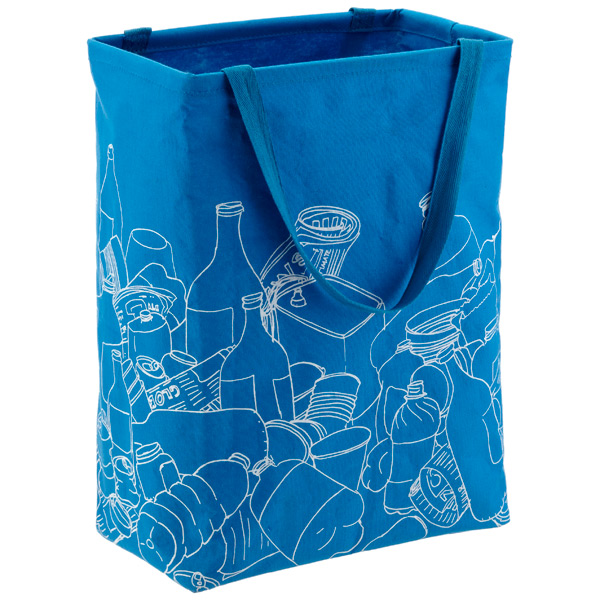Organize A Home Recycling Center
Intellectually, we all know how important it is to the environment for us to recycle. It means that we can decrease water and air pollution (resulting from landfills and incineration), reduce energy consumption for the production of new materials (and lower our carbon footprint) and use up fewer precious resources. In practical terms, however, it isn’t always so easy to achieve our recycling goals.
Success with any system depends on two parts: the physical and the behavioral. To improve your ability to recycle without inconvenience, you’re going to want to start by creating a home recycling center and developing rituals for making recycling easier.
BUILDING YOUR SYSTEM
- To start, check with local authorities to learn the rules for curbside pickup and community recycling center drop-off in your community. Find out if special bins are required and whether your area has all-in-one single-stream recycling or if you’ll have to separate glass, plastic, metal and paper recyclables.
- If you have curbside pickup, verify the dates and mark them on your calendar (the first Monday of each month? every other Friday?). Use a mobile reminder app to prompt you the day before pick-up so you don’t wait until the last minute. If the recycling center can’t come to you, you’ll have to go to the recycling center. Take note of the hours of operation for the center nearest you, and schedule drop-off dates throughout the month. Make it part of an outing — Saturday morning recycling, brunch, library and city park — so that you and your family anticipate the activity as part of a whole experience.
- The best location for initially collecting and sorting recyclables is in your kitchen, near where most cans or bottles are emptied. The under-sink area next to your trashcan is ideal, as you can rinse recyclables before sorting them into bins. Also consider lesser-used or partially hidden areas, like the floor space below a kitchen desk or the awkward corner cabinets where two counters meet at right angles.
- If you lack floor or cabinet space, go vertical! Use stackable recycling bins with tip-out openings or hang sturdy bags from hooks on the pantry or kitchen wall. Narrow bins can be arrayed on the base beneath a rolling food prep cart.
- Most kitchens lack ample space to store everything until recycling day, so use the kitchen recycling center as your sorting area and build a holding center in your garage, mud room, or laundry room to amass larger collections. When you carry kitchen trash to your garbage bin, take another moment to transfer kitchen recycling to the larger containers in the holding area.
- Fancy recycling bins may be aesthetically pleasing, but they aren’t essential. Traditional garbage cans or even canvas shopping or laundry bags are serviceable.
- Label or color-code containers so you know what kind of recycling goes in each to encourage family involvement and prevent mix-ups.
- Paper is usually generated outside of the kitchen, so set up a separate paper recycling station in the corner of your family room or home office, near your shredder. Even small amounts of paper get heavy quickly, so relocate paper recyclables to your holding area on a weekly basis.
- Don’t forget electronics recycling. You won’t need to keep on top of it as much as with paper, glass, plastic and metal, but having a system will keep the clutter from piling up. Designate an area of your house, perhaps a cardboard box in the garage or the floor of a closet, and when you buy new electronics to replace out-of-date or broken ones, toss whatever is no longer usable in the box. Office supply stores and “big box” stores like Staples, Office Depot and Best Buy are good options for recycling your electronics at little or no cost.
HOME RECYCLING RESOURCES
Motivation for keeping up with your recycling tasks means making your system simple, accessible, and attractive. (If it’s an eyesore, you’ll hide it away and forget to use it altogether.) Figure out whether you want multiple smaller containers, a larger container with dividers, or different kinds of tools for different types of recyclables. Some useful resources for building your home recycling center include:
Stacking Recycling Bins ($12/$18) at Container Store
Suncast Recycle Bins ($49/set of three) at Target

Recycle Crunch Can by Umbra ($12)
Recycle Bags ($13/set of two) at Great Useful Stuff
Folding Recycling Bags ($14/set of three) at Gaiam
Copyright © 2012, 2014, 2018 Julie Bestry and Best Results Organizing. All rights reserved.
About the Author: Julie Bestry is a professional organizer, speaker and author, who helps individuals and businesses save time and money, reduce stress and increase productivity through new organizational skills and systems. Her most recent book is 57 Secrets for Organizing Your Small Business. For information on how Julie can turn your chaos into serenity, visit Best Results Organizing at http://www.juliebestry.com.
You may reprint this article, as long as you include all of the above text, the About the Author box and a working link to http://www.juliebestry.com



Follow Me